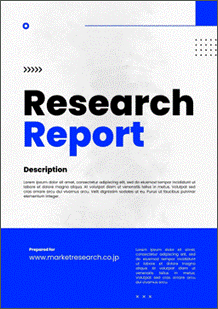 | • レポートコード:B-MOR-040411 • 出版社/出版日:Mordor Intelligence / 2018年3月 • レポート形態:英文、PDF、101ページ • 納品方法:Eメール(受注後2営業日) • 産業分類:医療・バイオ |
| Single User(1名様用) | ¥629,000 (USD4,250) | ▷ お問い合わせ |
| Team User(7名様用) | ¥666,000 (USD4,500) | ▷ お問い合わせ |
| Corporate User | ¥1,295,000 (USD8,750) | ▷ お問い合わせ |
• お支払方法:銀行振込(納品後、ご請求書送付)
レポート概要
| 本資料は、抗結核治療薬の世界市場について調べ、抗結核治療薬の世界規模、市場動向、市場環境、薬剤クラス別(イソニアジド、リファンピン、エタンブトール、ピラジンアミド、フルオロキノロン、ベダキリン、アミノグリコシド、チオアミド、環状ペプチド、その他)分析、エンドユーザー別(病院・診療所、政府機関、非営利組織、その他)分析、アメリカ市場規模、ヨーロッパ市場規模、アジア市場規模、日本市場規模、中国市場規模、企業の競争環境、関連企業情報などをまとめた調査レポートです。 ・イントロダクション ・エグゼクティブサマリー ・抗結核治療薬の世界市場インサイト ・抗結核治療薬の世界市場環境 ・抗結核治療薬の世界市場動向 ・抗結核治療薬の世界市場規模 ・抗結核治療薬の世界市場規模:薬剤クラス別(イソニアジド、リファンピン、エタンブトール、ピラジンアミド、フルオロキノロン、ベダキリン、アミノグリコシド、チオアミド、環状ペプチド、その他) ・抗結核治療薬の世界市場規模:エンドユーザー別(病院・診療所、政府機関、非営利組織、その他) ・抗結核治療薬の世界市場:地域別市場規模・分析 ・抗結核治療薬の北米市場規模・予測 ・抗結核治療薬のアメリカ市場規模・予測 ・抗結核治療薬のヨーロッパ市場規模・予測 ・抗結核治療薬のアジア市場規模・予測 ・抗結核治療薬の日本市場規模・予測 ・抗結核治療薬の中国市場規模・予測 ・抗結核治療薬のインド市場規模・予測 ・抗結核治療薬の韓国市場規模・予測 ・関連企業情報・競争状況 |
The global anti-tuberculosis Therapeutics market is expected to register a CAGR of 6.0% during the forecast period, 2018 to 2023. North America dominates the market, due to growing awareness regarding tuberculosis among the people.
Rising Prevalence of Tuberculosis (TB)
Rising prevalence of tuberculosis, especially in developing countries, is the major driver for the growth of the global anti-tuberculosis Therapeutics market. According to World Health Organization (WHO), in 2016, 10.4 million new tuberculosis cases were reported. Around 1.7 million TB patients died from the disease (which includes 0.4 million among people with HIV). Over 95% of TB deaths occur in low- and middle-income countries. Growing prevalence of pedriatic tuberculosis and increasing incidence of multi-drug-resistant tuberculosis (MDR TB) and extensively drug-resistant (XDR) TB cases are further driving the growth of the global tuberculosis Therapeutics market.
Also, growing initiative from government organization regarding awareness of tuberculosis, a collaboration between academic and private players for novel antibiotics drug development is another factor driving the growth of the global anti-tuberculosis drugs market.
High Cost of TB Therapeutics and Lack of Insurance Coverage in Low-and Middle-income Countries
Tuberculosis (TB) treatment is done over a long period, and continuous medicine and monitoring is needed during the treatment. This results in overall high treatment costs. According to reseach, on an average, the total cost of TB treatment was equivalent to 58% (5%-306%) of the reported annual individual income, and 39% (4%-148%) of the reported household income. This financial burden varies between countries, owing to varying healthcare settings, TB care models, general health systems, and social protection schemes. The financial burden is on an average more for persons suffering from MDR-TB and for the poorest. However, most of the low- and-middle income countries, such as Asian and African countries, have limited insurance coverage. Thus, high ‘out-of-pocket’ treatment cost, coupled with adverse side effects of anti-tuberculosis drugs, is expected to limit this market, as a large share of the population will not be able to afford the treatment. Factors, such as adverse side effects of anti-tuberculosis drugs, also hinder the market.
Asia-Pacific to Show High Growth Rate
North America dominates the global anti-tuberculosis Therapeutics market, owing to the presence of well-established market players, and raising awareness regarding tuberculosis. Asia-Pacific is expected to grow tremendously during the forecast period, owing to factors, such as high prevalence of tuberculosis and growing government initiative to create awareness regarding tuberculosis.
Key Developments in the Market
• August 2016: Mylan Inc., received approval from Drug Controller General of India (DCGI) regulatory body in India, to market anti-TB drug Delamanid in India.
• August 2017: Johnson & Johnson entered into a partnership with the Institute of Microbial Technology (IMTECH), part of the Council of Scientific and Industrial Research (CSIR), to accelerate the discovery of a novel treatment for tuberculosis.
Major Players: ASTRAZENECA PLC, BAYER AG, ELI LILLY AND COMPANY, GLAXOSMITHKLINE PLC, LUPIN PHARMACEUTICALS INC., NOVARTIS AG, PFIZER INC., SANDOZ INTERNATIONAL GMBH, SANOFI, AND JOHNSON & JOHNSON, among others.
Reasons to Purchase this Report
• Current and future global anti-tuberculosis therapeutics market outlook in the developed and emerging markets
• Analysis of various perspectives of the market with the help of Porter’s five forces analysis
• The segment that is expected to dominate the market
• Regions that are expected to witness the fastest growth during the forecast period
• Identify the latest developments, market shares, and strategies employed by the major market players
• 3 months analyst support, along with the Market Estimate sheet (in excel)
Customization of the Report
• This report can be customized to meet your requirements. Please connect with our representative, who will ensure you to get a report that suits your needs.
レポート目次1. Introduction
1.1 Market Definition
2. Research Methodology
3. Executive Summary
4. Key Inferences
5. Market Overview
5.1 Current Market Scenario
5.2 Porter’s Five Forces Analysis
5.2.1 Bargaining Power of Suppliers
5.2.2 Bargaining Power of Consumers
5.2.3 Threat of New Entrants
5.2.4 Threat of Substitute Product and Services
5.2.5 Competitive Rivalry within the Industry
6. Drivers, Restraints, Opportunities and Challenges Analysis (DROC)
6.1 Market Drivers
6.1.1 Risisng Prevalance of Tuberculosis
6.1.2 Growing Initiative from Government Organization for Tuberculosis Awareness
6.1.3 Collaboration Between Academic and Private Players for Novel Drug Development
6.1.4 Rising Incidence of MDR & XDR Cases in Developing Countries
6.2 Market Restraints
6.2.1 Adverse Side Effects of Anti-tuberculosis Drugs
6.2.2 High Cost of MDR & XDR TB Drugs
6.3 Opportunities
6.4 Key Challenges
7. Market Segmentation
7.1 By Drug Class
7.1.1 Isoniazid
7.1.2 Rifampin
7.1.3 Ethambutol
7.1.4 Pyrazinamide
7.1.5 Fluoroquinolones
7.1.6 Bedaquiline
7.1.7 Amynoglycosides
7.1.8 Thioamides
7.1.9 Cyclic Peptides
7.1.10 Others
7.2 By End User
7.2.1 Hospitals & Clinics
7.2.2 Government Agencies
7.2.3 Non Profit Organizations
7.2.4 Others
7.3 Segmentation – by Geography
7.3.1 North America
7.3.1.1 United States
7.3.1.2 Canada
7.3.1.3 Mexico
7.3.2 Europe
7.3.2.1 France
7.3.2.2 Germany
7.3.2.3 United Kingdom
7.3.2.4 Italy
7.3.2.5 Spain
7.3.2.6 Rest Of Europe
7.3.3 Asia-Pacific
7.3.3.1 China
7.3.3.2 Japan
7.3.3.3 India
7.3.3.4 Australia & New Zealand
7.3.3.5 South Korea
7.3.3.6 Rest of Asia-Pacific
7.3.4 Middle East & Africa
7.3.4.1 GCC
7.3.4.2 South Africa
7.3.4.3 Rest of the Middle East & Africa
7.3.5 South America
7.3.5.1 Brazil
7.3.5.2 Argentina
7.3.5.3 Rest of South America
8. Competitive Landscape
8.1 Mergers & Acquisition Analysis
8.2 Agreements, Collaborations, and Partnerships
8.3 New Products Launches
9. Key Players
9.1 AstraZeneca PLC
9.2 Bayer AG
9.3 Eli Lilly and Company
9.4 GlaxoSmithKline plc
9.5 Johnson & Johnson
9.6 Lupin Pharmaceuticals Inc.
9.7 Novartis AG
9.8 Pfizer Inc.
9.9 Sandoz International GmbH
9.10 Sanofi
9.11 Others
10. Future of the Market